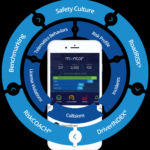Blog
Can You STOP a Crash Before It Happens?
Originally published in Fleet Management Weekly 7/5/2022

By Ed Dubens, CEO/Founder of eDriving
In short, absolutely!
But first, let’s clarify what we are discussing – the use of statistical techniques from data mining, predictive modeling and machine learning that analyze current and historical facts to make predictions about future or otherwise unknown events – in this case, road traffic collisions.
Predictive analytics and predictive modeling have been at the center of enterprise driver risk management for many years, yet many predictive models do not provide an effective and complete approach. These days, some believe that telematics alone is all that is needed to make effective risk management decisions that protect both employees while driving for work purposes, as well as the wider community in which your employees live and work.
Don’t get me wrong, telematics technology is incredible, is at the core of our evolving business, and without its contribution, most models are dependent upon “lagging indicators” or historical facts like incident, collision, and license violation history.
Our thesis is that a methodology that combines both leading and lagging indicators into a single system is essential to creating the most effective approach. Namely, this relates to a fundamental understanding of your most at-risk drivers in a group who need further support, coaching, and training to prevent crashes from happening!
 Over the last 25 years, identifying the most at-risk drivers in any group has been at the core of our mission. We began by using Lotus 123 to explore behaviors that led to a collision, then layering in validated attitude, knowledge, and behavior risk assessments. We then progressed this by adding in license violation event data, right up to the present day where we combine all of this information with the mighty FICO® Safe Driving Score – a powerful leading indicator of risk, a result achieved by bringing together real-time driver behaviors from behind the wheel – acceleration, braking, cornering, distraction and speeding.
Over the last 25 years, identifying the most at-risk drivers in any group has been at the core of our mission. We began by using Lotus 123 to explore behaviors that led to a collision, then layering in validated attitude, knowledge, and behavior risk assessments. We then progressed this by adding in license violation event data, right up to the present day where we combine all of this information with the mighty FICO® Safe Driving Score – a powerful leading indicator of risk, a result achieved by bringing together real-time driver behaviors from behind the wheel – acceleration, braking, cornering, distraction and speeding.
It is just as important to understand why events are happening as it is to know that they have happened or are currently happening behind the wheel. As we all know, 94%* of collisions are influenced by a driver’s attitude and behavior regarding road safety, but what influences a driver’s attitude and behavior?
Psychometrics, the home environment, knowledge of defensive driving best practices, personal circumstances, work pressure, and much more can contribute to a driver’s at-risk attitude and behaviors. Capturing the event data, with both leading and lagging indicators is crucial, but taking the time to understand the who, what, why, when, which and how of an event is where the critical impact lies, as management teams can intervene with the most at-risk drivers proactively and address the risky behaviors identified!
Bree Bryant, VP of Safety at Eagle Transport in North Carolina, and a client of eDriving for over 15 years, says that “Eagle can’t help but have a high exposure to both collision and product-handling risks, making predictive modeling well worth the investment. We use the approach to quickly identify at-risk employees, taking into account collisions, incidents, motor vehicle records, and 3rd party telematics data to give a numeric value to a driver’s safety performance. The higher that value, the higher the safety issues or severity of issues for that driver”.
Similar results have been reported from BT in the UK, a client for over 20 years, which operates one of the largest motor fleets in Europe. Since introducing predictive modeling as a driver risk management solution, BT has reduced collision rates and costs by approximately 40%, saving approximately $15 million per year in the process. BT Group Risk Manager, Dave Wallington, commented that, “given our scale and scope, predictive modeling has allowed us to assess and reduce the risks faced by our people when they are out on the roads in the most cost-effective way. The results achieved so far have repaid our investment several times over and the ongoing system development will allow us even better visibility and linkages of all our risk assessment, training, collision and license data streams”.
Ultimately, the heart of our mission at eDriving is to help our clients develop and sustain their “crash free culture” and help drivers return home safely at the end of each workday. Businesses that embrace predictive modeling into their approach are rewarded with a dynamic sustainable approach that recognizes low-risk drivers and identifies high-risk drivers in near real-time for further support and coaching.
*NHTSA study looked at the major crash causes and found that a mere 2% of crashes were caused by the environment, another 2% were caused by the vehicles, and 2% came from “unknown” causes. A full 94% of crashes, meanwhile, were caused by mistakes made by drivers.
About the Author
Ed’s passion is helping companies proactively manage driver risk and prioritize the safety of their employees who drive for work purposes. The ultimate goal of eDriving’s programs is to help drivers return home safely to their loved ones and communities at the end of each day. Ed has been fortunate enough to be living out his passion for over 25 years, impacting lives and helping transform the field of driver risk management along the way.